Ad-Hoc wireless networks • A network of
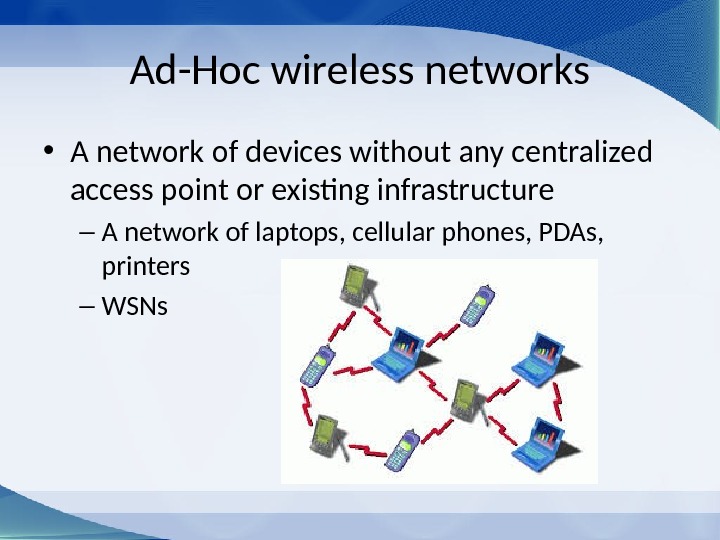
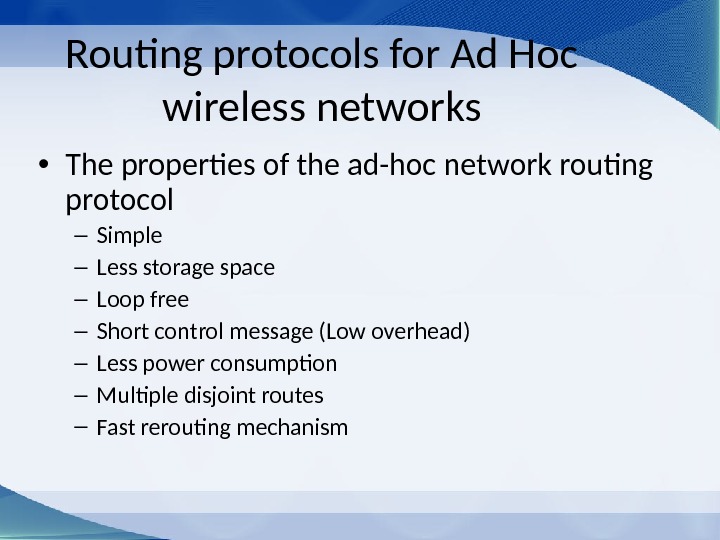
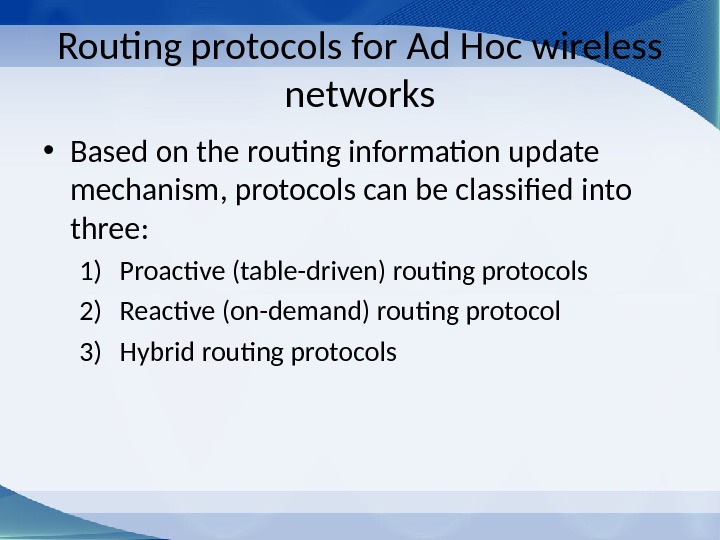
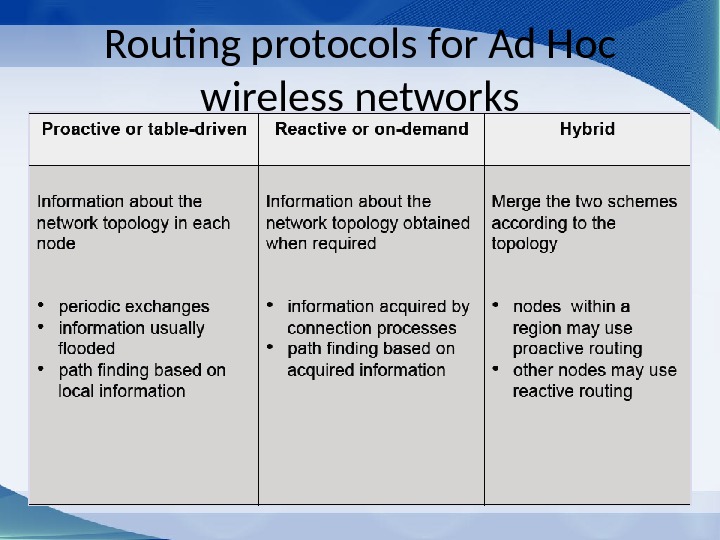

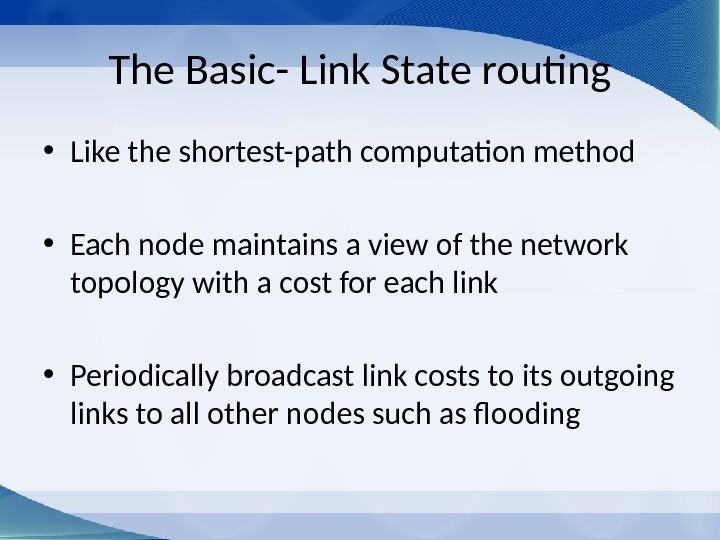
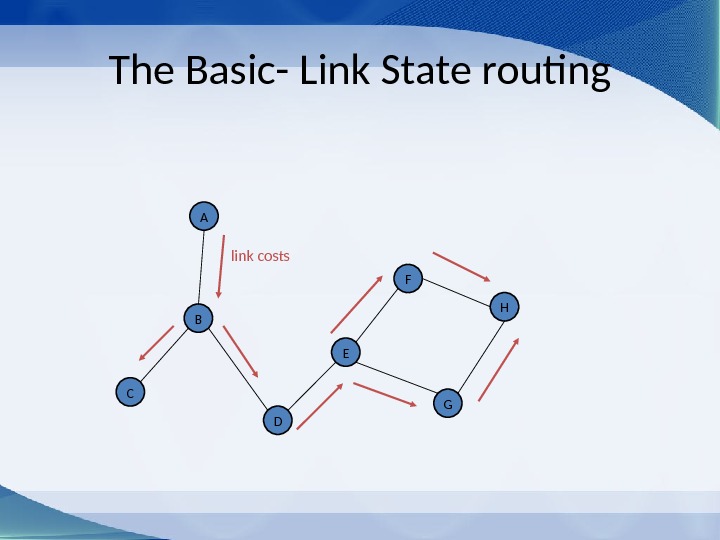
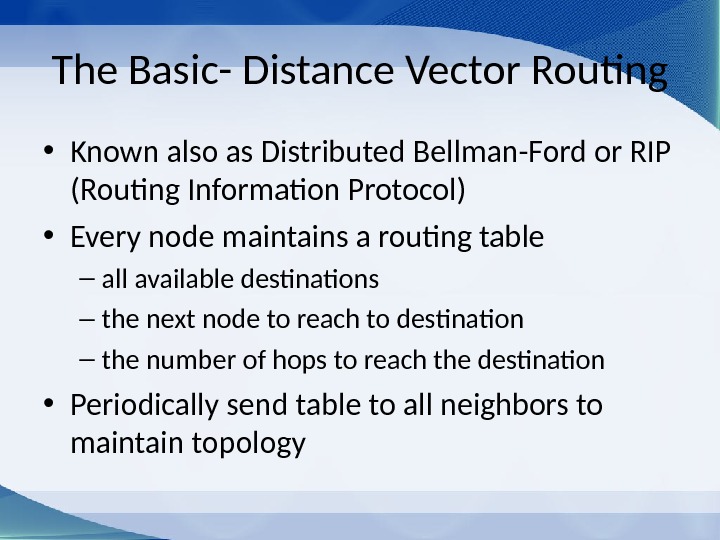
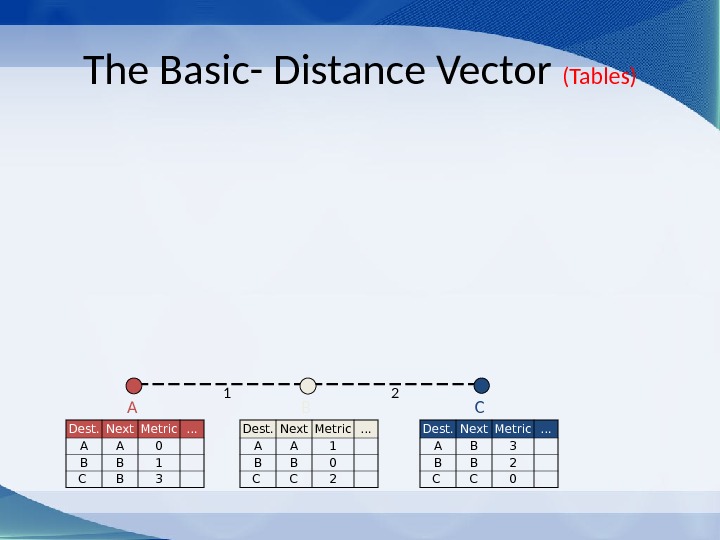
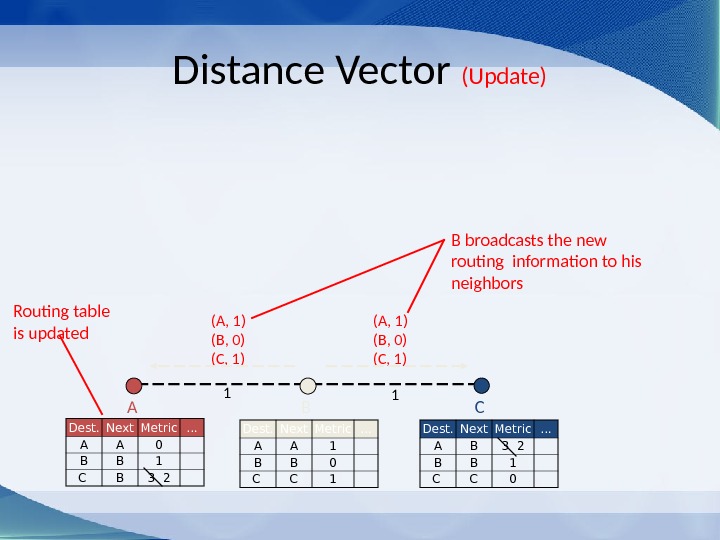
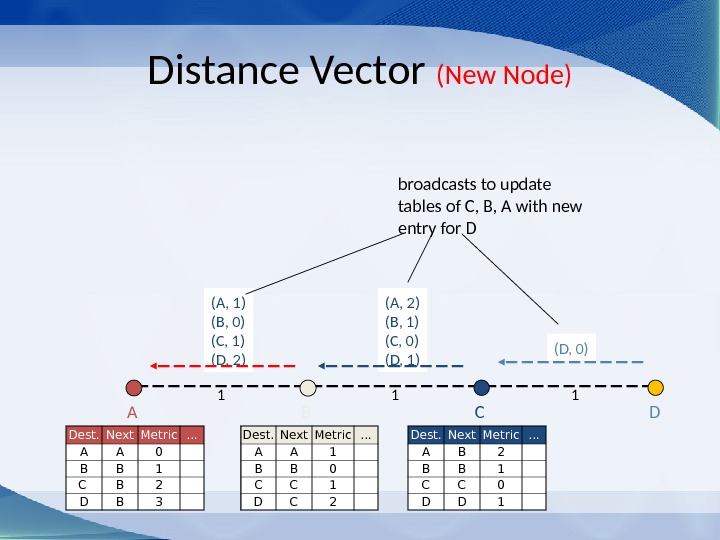

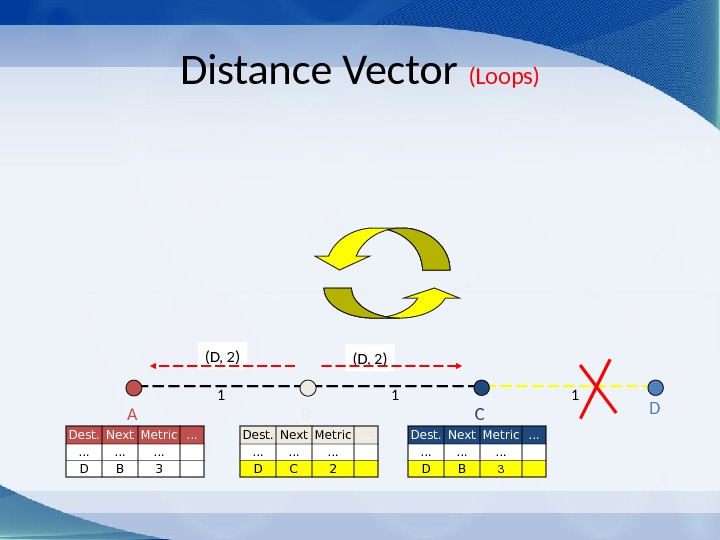
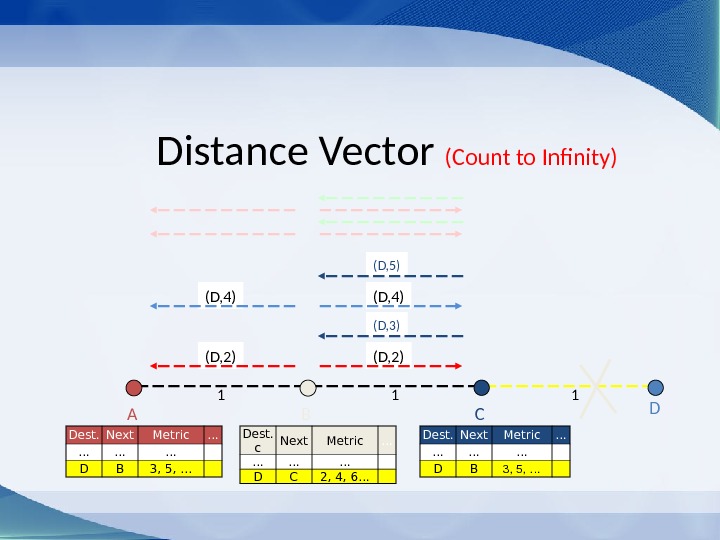

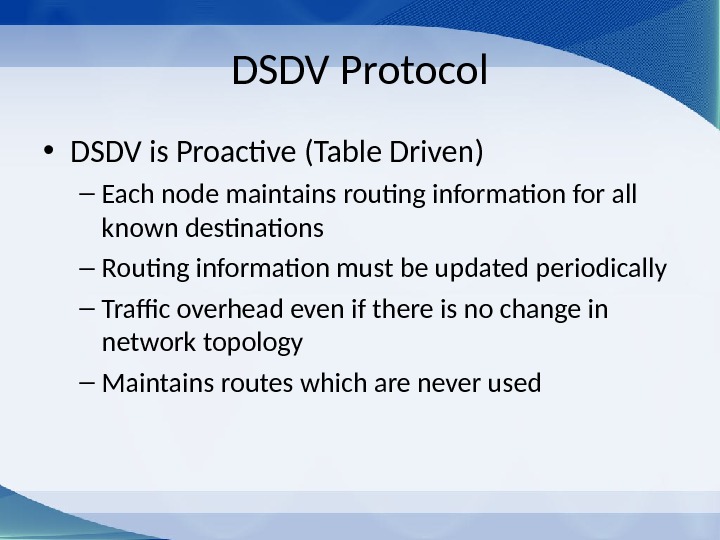

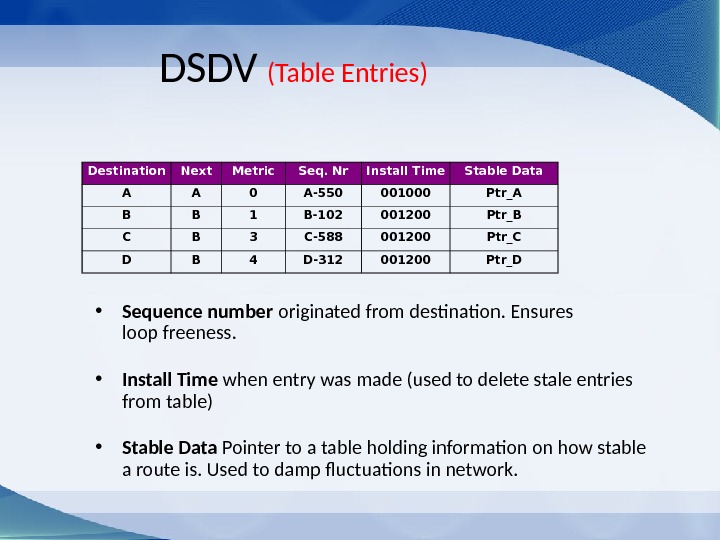
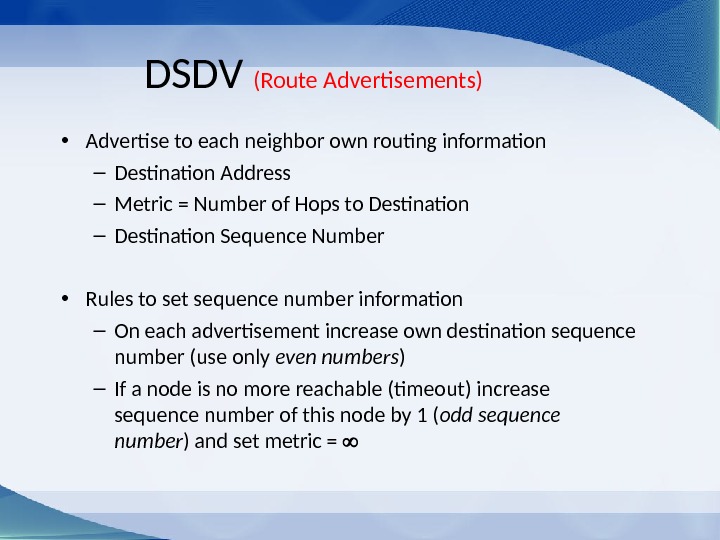

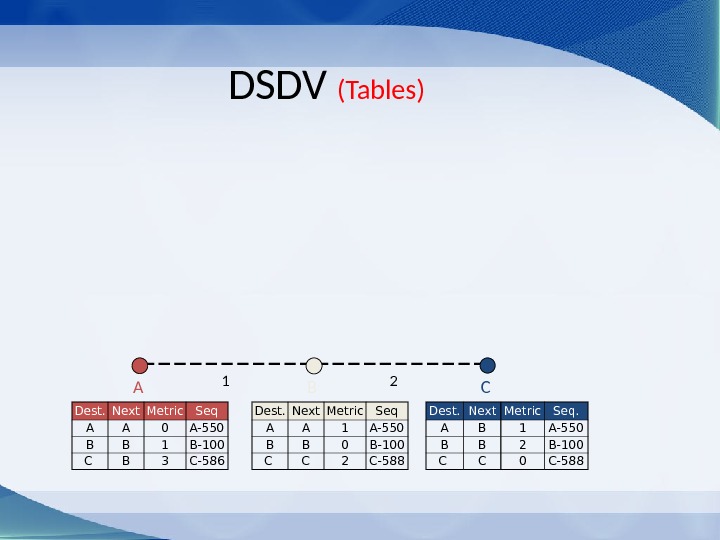
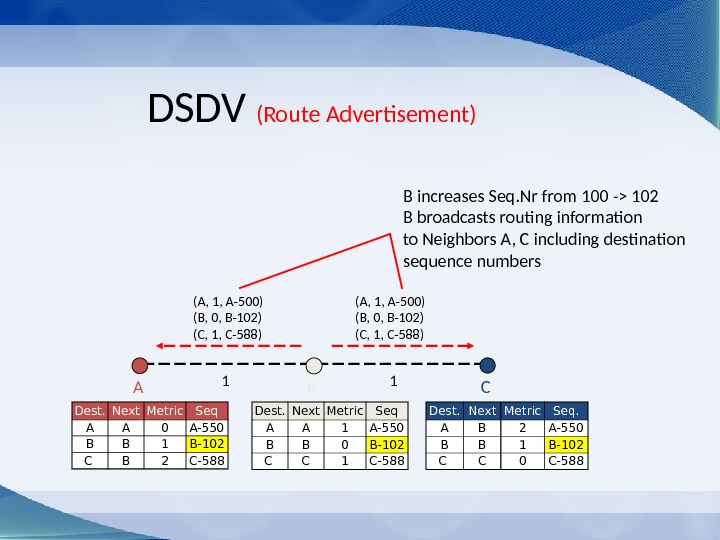
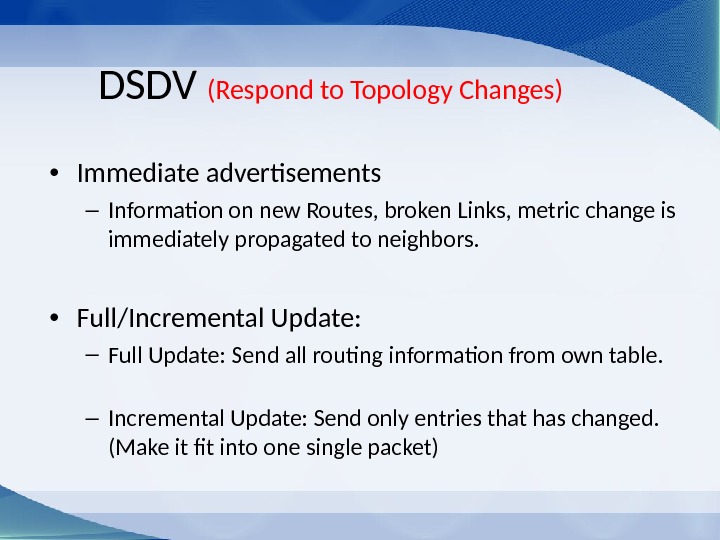
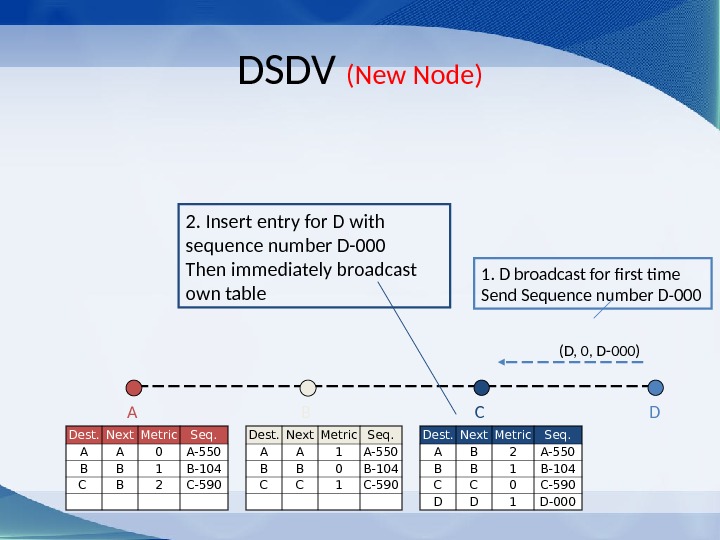

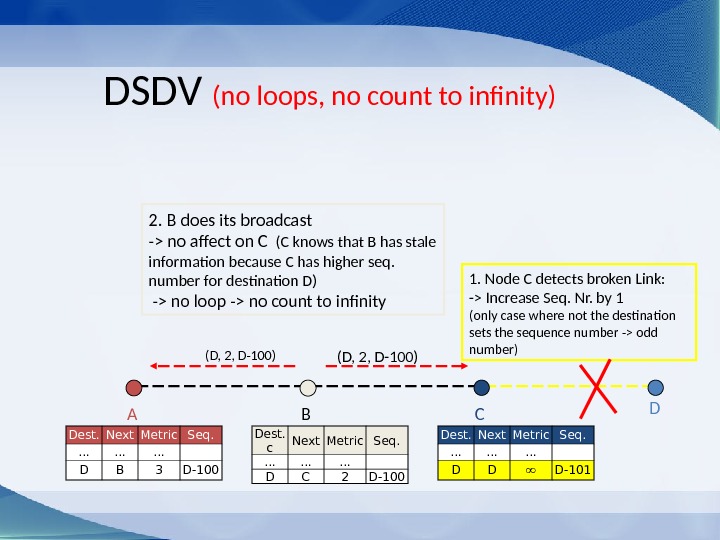
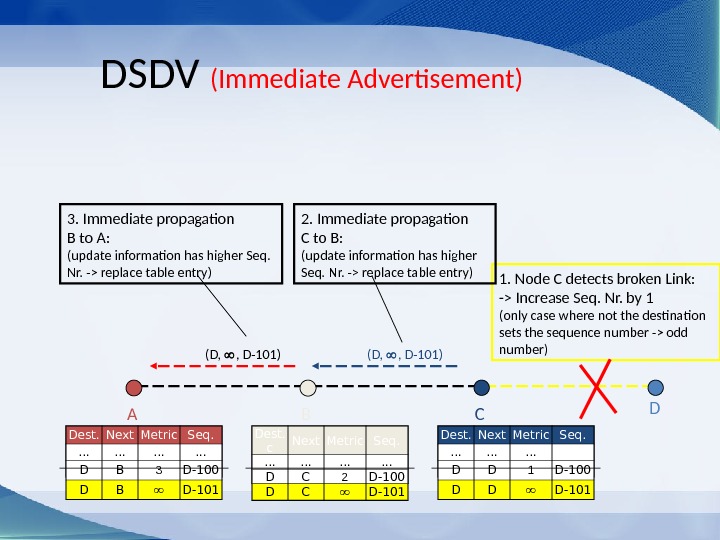
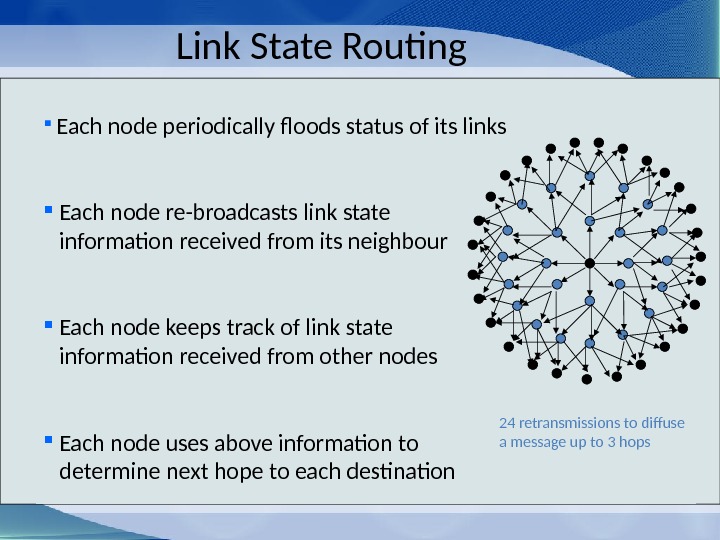

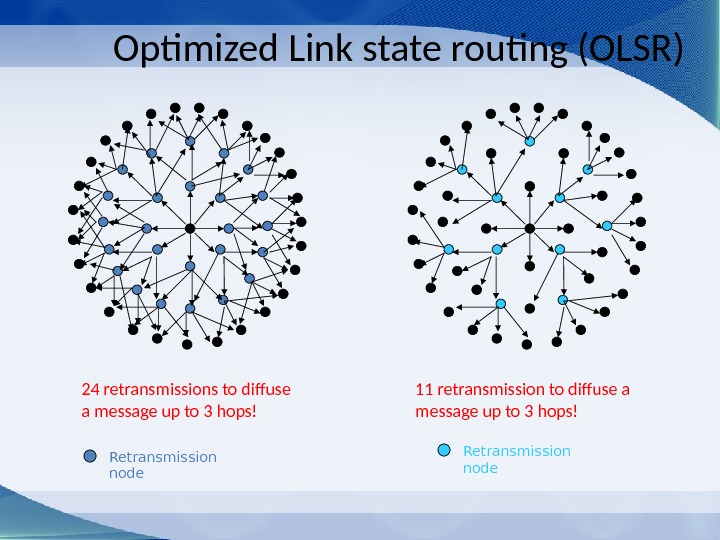


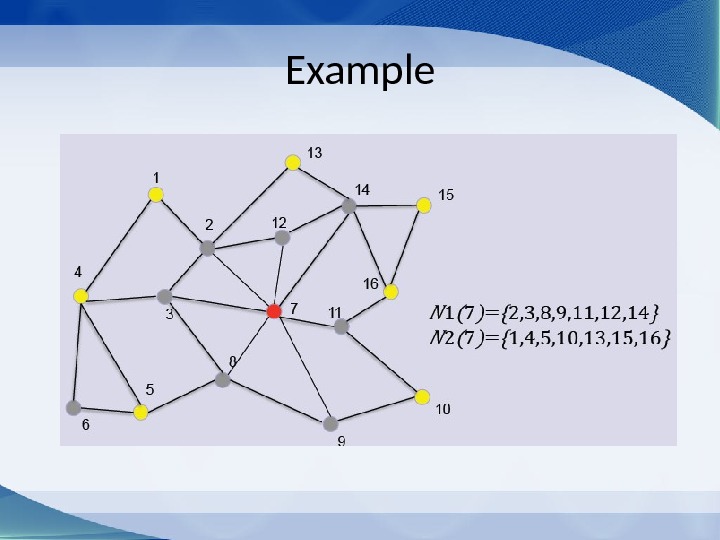
- Размер: 2 Mегабайта
- Количество слайдов: 33
Описание презентации Ad-Hoc wireless networks • A network of по слайдам
 Ad-Hoc wireless networks • A network of devices without any centralized access point or existing infrastructure – A network of laptops, cellular phones, PDAs, printers – WSNs
Ad-Hoc wireless networks • A network of devices without any centralized access point or existing infrastructure – A network of laptops, cellular phones, PDAs, printers – WSNs
 Routing protocols for Ad Hoc wireless networks • The properties of the ad-hoc network routing protocol – Simple – Less storage space – Loop free – Short control message (Low overhead) – Less power consumption – Multiple disjoint routes – Fast rerouting mechanism
Routing protocols for Ad Hoc wireless networks • The properties of the ad-hoc network routing protocol – Simple – Less storage space – Loop free – Short control message (Low overhead) – Less power consumption – Multiple disjoint routes – Fast rerouting mechanism
 Routing protocols for Ad Hoc wireless networks • Based on the routing information update mechanism, protocols can be classified into three: 1) Proactive (table-driven) routing protocols 2) Reactive (on-demand) routing protocol 3) Hybrid routing protocols
Routing protocols for Ad Hoc wireless networks • Based on the routing information update mechanism, protocols can be classified into three: 1) Proactive (table-driven) routing protocols 2) Reactive (on-demand) routing protocol 3) Hybrid routing protocols
 Routing protocols for Ad Hoc wireless networks
Routing protocols for Ad Hoc wireless networks
 5 The Basics — Flooding • Simplest of all routing protocols • Send all info to everybody – If data not for you, send to all neighbors • Robust – destination is almost guaranteed to receive data • Resource Intensive – unnecessary traffic – load increases, network performance drops quickly
5 The Basics — Flooding • Simplest of all routing protocols • Send all info to everybody – If data not for you, send to all neighbors • Robust – destination is almost guaranteed to receive data • Resource Intensive – unnecessary traffic – load increases, network performance drops quickly
 The Basic- Link State routing • Like the shortest-path computation method • Each node maintains a view of the network topology with a cost for each link • Periodically broadcast link costs to its outgoing links to all other nodes such as flooding
The Basic- Link State routing • Like the shortest-path computation method • Each node maintains a view of the network topology with a cost for each link • Periodically broadcast link costs to its outgoing links to all other nodes such as flooding
 The Basic- Link State routing EB D G HFA C link costs
The Basic- Link State routing EB D G HFA C link costs
 The Basic- Distance Vector Routing • Known also as Distributed Bellman-Ford or RIP (Routing Information Protocol) • Every node maintains a routing table – all available destinations – the next node to reach to destination – the number of hops to reach the destination • Periodically send table to all neighbors to maintain topology
The Basic- Distance Vector Routing • Known also as Distributed Bellman-Ford or RIP (Routing Information Protocol) • Every node maintains a routing table – all available destinations – the next node to reach to destination – the number of hops to reach the destination • Periodically send table to all neighbors to maintain topology
 The Basic- Distance Vector (Tables) C Dest. Next Metric … A A 1 B B 0 C C 2 Dest. Next Metric … A A 0 B B 1 C B 3 1 2 Dest. Next Metric …
The Basic- Distance Vector (Tables) C Dest. Next Metric … A A 1 B B 0 C C 2 Dest. Next Metric … A A 0 B B 1 C B 3 1 2 Dest. Next Metric …
 (A, 1) (B, 0) (C, 1)Distance Vector (Update) C Dest. Next Metric … A A 1 B B 0 C C 1 Dest. Next Metric … A A 0 B B 1 C B 3 2 1 1 Dest. Next Metric … A B 3 2 B B 1 C C 0 BA B broadcasts the new routing information to his neighbors Routing table is updated
(A, 1) (B, 0) (C, 1)Distance Vector (Update) C Dest. Next Metric … A A 1 B B 0 C C 1 Dest. Next Metric … A A 0 B B 1 C B 3 2 1 1 Dest. Next Metric … A B 3 2 B B 1 C C 0 BA B broadcasts the new routing information to his neighbors Routing table is updated
 (D, 0)(A, 2) (B, 1) (C, 0) (D, 1)(A, 1) (B, 0) (C, 1) (D, 2)Distance Vector (New Node) C 1 1 BA D 1 broadcasts to update tables of C, B, A with new entry for D Dest. Next Metric … A B 2 B B 1 C C 0 D D 1 Dest. Next Metric … A A 1 B B 0 C C 1 D C 2 Dest. Next Metric …
(D, 0)(A, 2) (B, 1) (C, 0) (D, 1)(A, 1) (B, 0) (C, 1) (D, 2)Distance Vector (New Node) C 1 1 BA D 1 broadcasts to update tables of C, B, A with new entry for D Dest. Next Metric … A B 2 B B 1 C C 0 D D 1 Dest. Next Metric … A A 1 B B 0 C C 1 D C 2 Dest. Next Metric …
 Distance Vector (Broken Link) C 1 1 BA D 1 Dest. c Next Metric … … D C 2 Dest. Next Metric … … D B 3 Dest. Next Metric … … D B 1 Dest. Next Metric … …
Distance Vector (Broken Link) C 1 1 BA D 1 Dest. c Next Metric … … D C 2 Dest. Next Metric … … D B 3 Dest. Next Metric … … D B 1 Dest. Next Metric … …
 (D, 2)Distance Vector (Loops) C 1 1 BA D 1 Dest. Next Metric … … D B 3 Dest. Next Metric … … D C 2 Dest. Next Metric … …
(D, 2)Distance Vector (Loops) C 1 1 BA D 1 Dest. Next Metric … … D B 3 Dest. Next Metric … … D C 2 Dest. Next Metric … …
 (D, 2)(D, 4) (D, 3)(D, 5) (D, 2)(D, 4)Distance Vector (Count to Infinity) C 1 1 BA D 1 Dest. Next Metric … … … … D B 3, 5, …Dest. c Next Metric … … D C 2, 4, 6…
(D, 2)(D, 4) (D, 3)(D, 5) (D, 2)(D, 4)Distance Vector (Count to Infinity) C 1 1 BA D 1 Dest. Next Metric … … … … D B 3, 5, …Dest. c Next Metric … … D C 2, 4, 6…
 Distance Vector • DV not suited for ad-hoc networks! – Loops – Count to Infinity • New Solution -> DSDV Protocol
Distance Vector • DV not suited for ad-hoc networks! – Loops – Count to Infinity • New Solution -> DSDV Protocol
 DSDV Protocol • DSDV is Proactive (Table Driven) – Each node maintains routing information for all known destinations – Routing information must be updated periodically – Traffic overhead even if there is no change in network topology – Maintains routes which are never used
DSDV Protocol • DSDV is Proactive (Table Driven) – Each node maintains routing information for all known destinations – Routing information must be updated periodically – Traffic overhead even if there is no change in network topology – Maintains routes which are never used
 DSDV Protocol • Keep the simplicity of Distance Vector • Guarantee Loop Freeness – New Table Entry for Destination Sequence Number • Allow fast reaction to topology changes – Make immediate route advertisement on significant changes in routing table
DSDV Protocol • Keep the simplicity of Distance Vector • Guarantee Loop Freeness – New Table Entry for Destination Sequence Number • Allow fast reaction to topology changes – Make immediate route advertisement on significant changes in routing table
 DSDV (Table Entries) • Sequence number originated from destination. Ensures loop freeness. • Install Time when entry was made (used to delete stale entries from table) • Stable Data Pointer to a table holding information on how stable a route is. Used to damp fluctuations in network. Destination Next Metric Seq. Nr Install Time Stable Data A A 0 A-550 001000 Ptr_A B B 1 B-102 001200 Ptr_B C B 3 C-588 001200 Ptr_C D B 4 D-312 001200 Ptr_
DSDV (Table Entries) • Sequence number originated from destination. Ensures loop freeness. • Install Time when entry was made (used to delete stale entries from table) • Stable Data Pointer to a table holding information on how stable a route is. Used to damp fluctuations in network. Destination Next Metric Seq. Nr Install Time Stable Data A A 0 A-550 001000 Ptr_A B B 1 B-102 001200 Ptr_B C B 3 C-588 001200 Ptr_C D B 4 D-312 001200 Ptr_
 DSDV (Route Advertisements) • Advertise to each neighbor own routing information – Destination Address – Metric = Number of Hops to Destination – Destination Sequence Number • Rules to set sequence number information – On each advertisement increase own destination sequence number (use only even numbers ) – If a node is no more reachable (timeout) increase sequence number of this node by 1 ( odd sequence number ) and set metric =
DSDV (Route Advertisements) • Advertise to each neighbor own routing information – Destination Address – Metric = Number of Hops to Destination – Destination Sequence Number • Rules to set sequence number information – On each advertisement increase own destination sequence number (use only even numbers ) – If a node is no more reachable (timeout) increase sequence number of this node by 1 ( odd sequence number ) and set metric =
 DSDV (Route Selection) • Update information is compared to own routing table 1. Select route with higher destination sequence number (This ensure to use always newest information from destination) 2. Select the route with better metric when sequence numbers are equal.
DSDV (Route Selection) • Update information is compared to own routing table 1. Select route with higher destination sequence number (This ensure to use always newest information from destination) 2. Select the route with better metric when sequence numbers are equal.
 DSDV (Tables) C Dest. Next Metric Seq A A 1 A-550 B B 0 B-100 C C 2 C-588 Dest. Next Metric Seq A A 0 A-550 B B 1 B-100 C B 3 C-586 Dest. Next Metric Seq. A B 1 A-550 B B 2 B-100 C C 0 C-
DSDV (Tables) C Dest. Next Metric Seq A A 1 A-550 B B 0 B-100 C C 2 C-588 Dest. Next Metric Seq A A 0 A-550 B B 1 B-100 C B 3 C-586 Dest. Next Metric Seq. A B 1 A-550 B B 2 B-100 C C 0 C-
 (A, 1, A-500) (B, 0, B-102) (C, 1, C-588)DSDV (Route Advertisement) CBA B increases Seq. Nr from 100 -> 102 B broadcasts routing information to Neighbors A, C including destination sequence numbers Dest. Next Metric Seq A A 0 A-550 B B 1 B-102 C B 2 C-588 Dest. Next Metric Seq A A 1 A-550 B B 0 B-102 C C 1 C-588 Dest. Next Metric Seq. A B 2 A-550 B B 1 B-102 C C 0 C-
(A, 1, A-500) (B, 0, B-102) (C, 1, C-588)DSDV (Route Advertisement) CBA B increases Seq. Nr from 100 -> 102 B broadcasts routing information to Neighbors A, C including destination sequence numbers Dest. Next Metric Seq A A 0 A-550 B B 1 B-102 C B 2 C-588 Dest. Next Metric Seq A A 1 A-550 B B 0 B-102 C C 1 C-588 Dest. Next Metric Seq. A B 2 A-550 B B 1 B-102 C C 0 C-
 DSDV (Respond to Topology Changes) • Immediate advertisements – Information on new Routes, broken Links, metric change is immediately propagated to neighbors. • Full/Incremental Update: – Full Update: Send all routing information from own table. – Incremental Update: Send only entries that has changed. (Make it fit into one single packet)
DSDV (Respond to Topology Changes) • Immediate advertisements – Information on new Routes, broken Links, metric change is immediately propagated to neighbors. • Full/Incremental Update: – Full Update: Send all routing information from own table. – Incremental Update: Send only entries that has changed. (Make it fit into one single packet)
 (D, 0, D-000)DSDV (New Node) CBA D Dest. Next Metric Seq. A A 0 A-550 B B 1 B-104 C B 2 C-590 Dest. Next Metric Seq. A A 1 A-550 B B 0 B-104 C C 1 C-590 Dest. Next Metric Seq. A B 2 A-550 B B 1 B-104 C C 0 C-590 D D 1 D-0001. D broadcast for first time Send Sequence number D-0002. Insert entry for D with sequence number D-000 Then immediately broadcast own table
(D, 0, D-000)DSDV (New Node) CBA D Dest. Next Metric Seq. A A 0 A-550 B B 1 B-104 C B 2 C-590 Dest. Next Metric Seq. A A 1 A-550 B B 0 B-104 C C 1 C-590 Dest. Next Metric Seq. A B 2 A-550 B B 1 B-104 C C 0 C-590 D D 1 D-0001. D broadcast for first time Send Sequence number D-0002. Insert entry for D with sequence number D-000 Then immediately broadcast own table
 (A, 2, A-550) (B, 1, B-102) (C, 0, C-592) (D, 1, D-000)DSDV (New Node cont. ) CBA D Dest. Next Metric Seq. A A 1 A-550 B B 0 B-102 C C 1 C-592 D C 2 D-000 Dest. Next Metric Seq. A A 0 A-550 B B 1 B-104 C B 2 C-590 Dest. Next Metric Seq. A B 2 A-550 B B 1 B-102 C C 0 C-592 D D 1 D-000……… 3. C increases its sequence number to C-592 then broadcasts its new table. 4. B gets this new information and updates its table…….
(A, 2, A-550) (B, 1, B-102) (C, 0, C-592) (D, 1, D-000)DSDV (New Node cont. ) CBA D Dest. Next Metric Seq. A A 1 A-550 B B 0 B-102 C C 1 C-592 D C 2 D-000 Dest. Next Metric Seq. A A 0 A-550 B B 1 B-104 C B 2 C-590 Dest. Next Metric Seq. A B 2 A-550 B B 1 B-102 C C 0 C-592 D D 1 D-000……… 3. C increases its sequence number to C-592 then broadcasts its new table. 4. B gets this new information and updates its table…….
 (D, 2, D-100)DSDV (no loops, no count to infinity) CBA D Dest. c Next Metric Seq. … … … D C 2 D-100 Dest. Next Metric Seq. … … … D B 3 D-100 Dest. Next Metric Seq. … … … D D D-1011. Node C detects broken Link: -> Increase Seq. Nr. by 1 (only case where not the destination sets the sequence number -> odd number)2. B does its broadcast -> no affect on C (C knows that B has stale information because C has higher seq. number for destination D) -> no loop -> no count to infinity
(D, 2, D-100)DSDV (no loops, no count to infinity) CBA D Dest. c Next Metric Seq. … … … D C 2 D-100 Dest. Next Metric Seq. … … … D B 3 D-100 Dest. Next Metric Seq. … … … D D D-1011. Node C detects broken Link: -> Increase Seq. Nr. by 1 (only case where not the destination sets the sequence number -> odd number)2. B does its broadcast -> no affect on C (C knows that B has stale information because C has higher seq. number for destination D) -> no loop -> no count to infinity
 (D, , D-101)DSDV (Immediate Advertisement) CBA D Dest. c Next Metric Seq. … … … D C 3 D-100 Dest. Next Metric Seq. … … … D B 4 D-100 Dest. Next Metric Seq. … … … D B 1 D-100 Dest. Next Metric Seq. … … … D D 1 D-100 D D D-1011. Node C detects broken Link: -> Increase Seq. Nr. by 1 (only case where not the destination sets the sequence number -> odd number)3. Immediate propagation B to A: (update information has higher Seq. Nr. -> replace table entry) 2. Immediate propagation C to B: (update information has higher Seq. Nr. -> replace table entry) Dest. c Next Metric Seq. … … …. . . D C 2 D-100 D C D-101 Dest. Next Metric Seq. … … …. . . D B 3 D-100 D B D-
(D, , D-101)DSDV (Immediate Advertisement) CBA D Dest. c Next Metric Seq. … … … D C 3 D-100 Dest. Next Metric Seq. … … … D B 4 D-100 Dest. Next Metric Seq. … … … D B 1 D-100 Dest. Next Metric Seq. … … … D D 1 D-100 D D D-1011. Node C detects broken Link: -> Increase Seq. Nr. by 1 (only case where not the destination sets the sequence number -> odd number)3. Immediate propagation B to A: (update information has higher Seq. Nr. -> replace table entry) 2. Immediate propagation C to B: (update information has higher Seq. Nr. -> replace table entry) Dest. c Next Metric Seq. … … …. . . D C 2 D-100 D C D-101 Dest. Next Metric Seq. … … …. . . D B 3 D-100 D B D-
 Link State Routing Each node periodically floods status of its links Each node re-broadcasts link state information received from its neighbour Each node keeps track of link state information received from other nodes Each node uses above information to determine next hope to each destination 24 retransmissions to diffuse a message up to 3 hops
Link State Routing Each node periodically floods status of its links Each node re-broadcasts link state information received from its neighbour Each node keeps track of link state information received from other nodes Each node uses above information to determine next hope to each destination 24 retransmissions to diffuse a message up to 3 hops
 Optimized Link state routing ( OLSR)
Optimized Link state routing ( OLSR)
 Optimized Link state routing (OLSR) 24 retransmissions to diffuse a message up to 3 hops! Retransmission node 11 retransmission to diffuse a message up to 3 hops! Retransmission node
Optimized Link state routing (OLSR) 24 retransmissions to diffuse a message up to 3 hops! Retransmission node 11 retransmission to diffuse a message up to 3 hops! Retransmission node
 Qamar A Tarar OLSR Protocol 31 Description of OLSR * MPR (Multipoint relays) * MPR selector * S ymmetric 1 -hop neighbours * S ymmetric strict 2 -hop neighbours S M X Y ZP
Qamar A Tarar OLSR Protocol 31 Description of OLSR * MPR (Multipoint relays) * MPR selector * S ymmetric 1 -hop neighbours * S ymmetric strict 2 -hop neighbours S M X Y ZP
 Selecting Multipoint relays
Selecting Multipoint relays
 Example
Example
